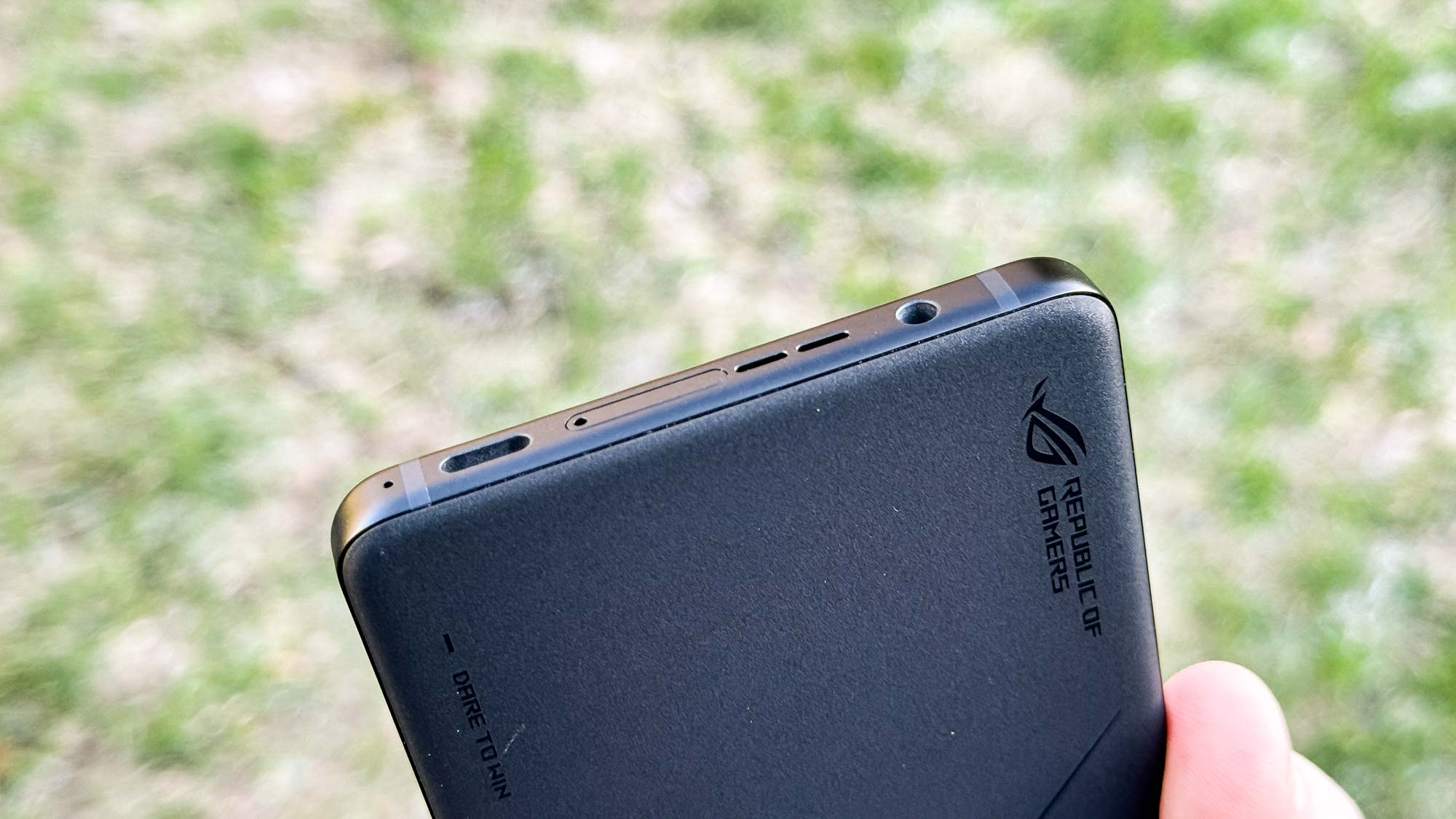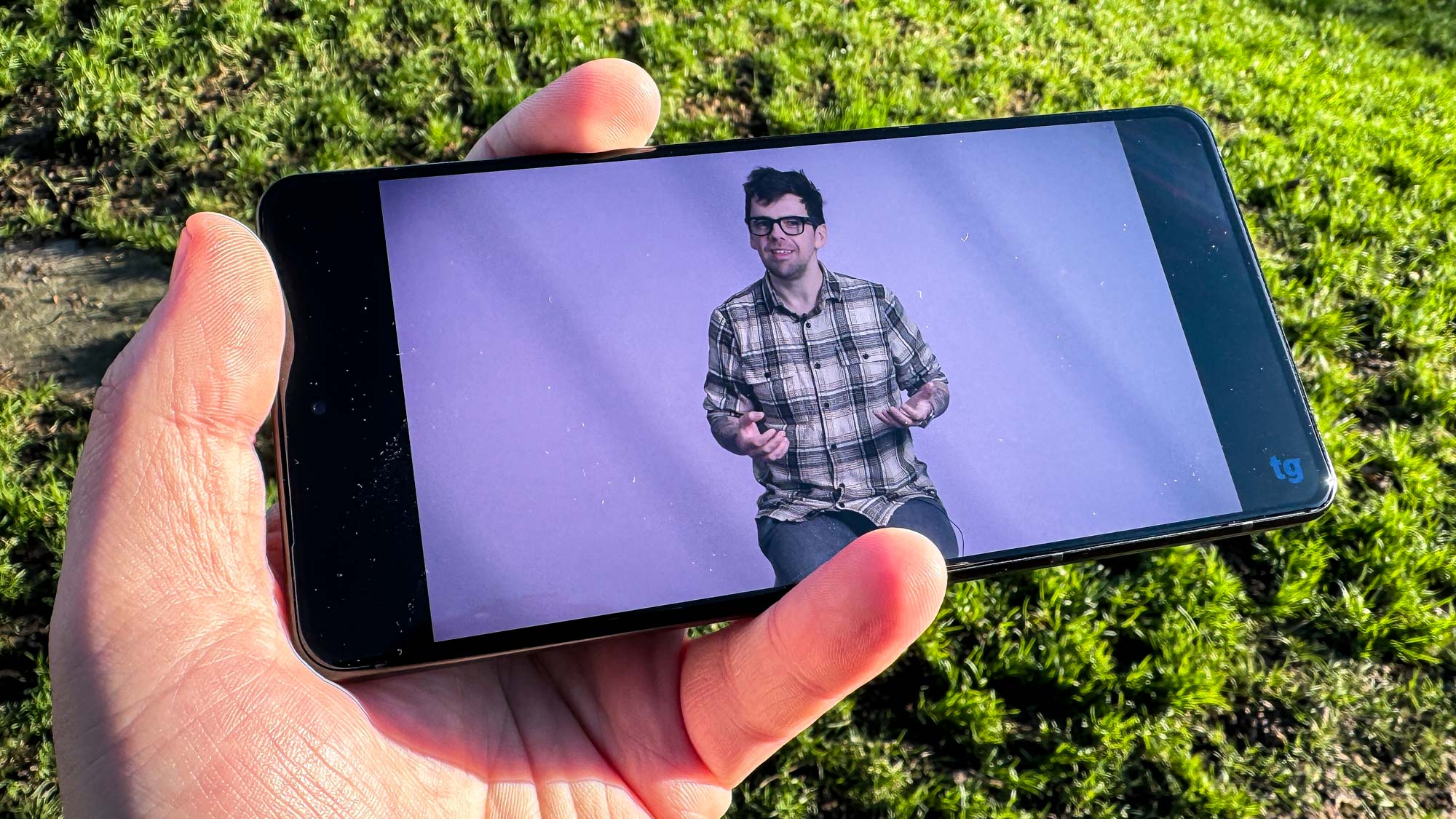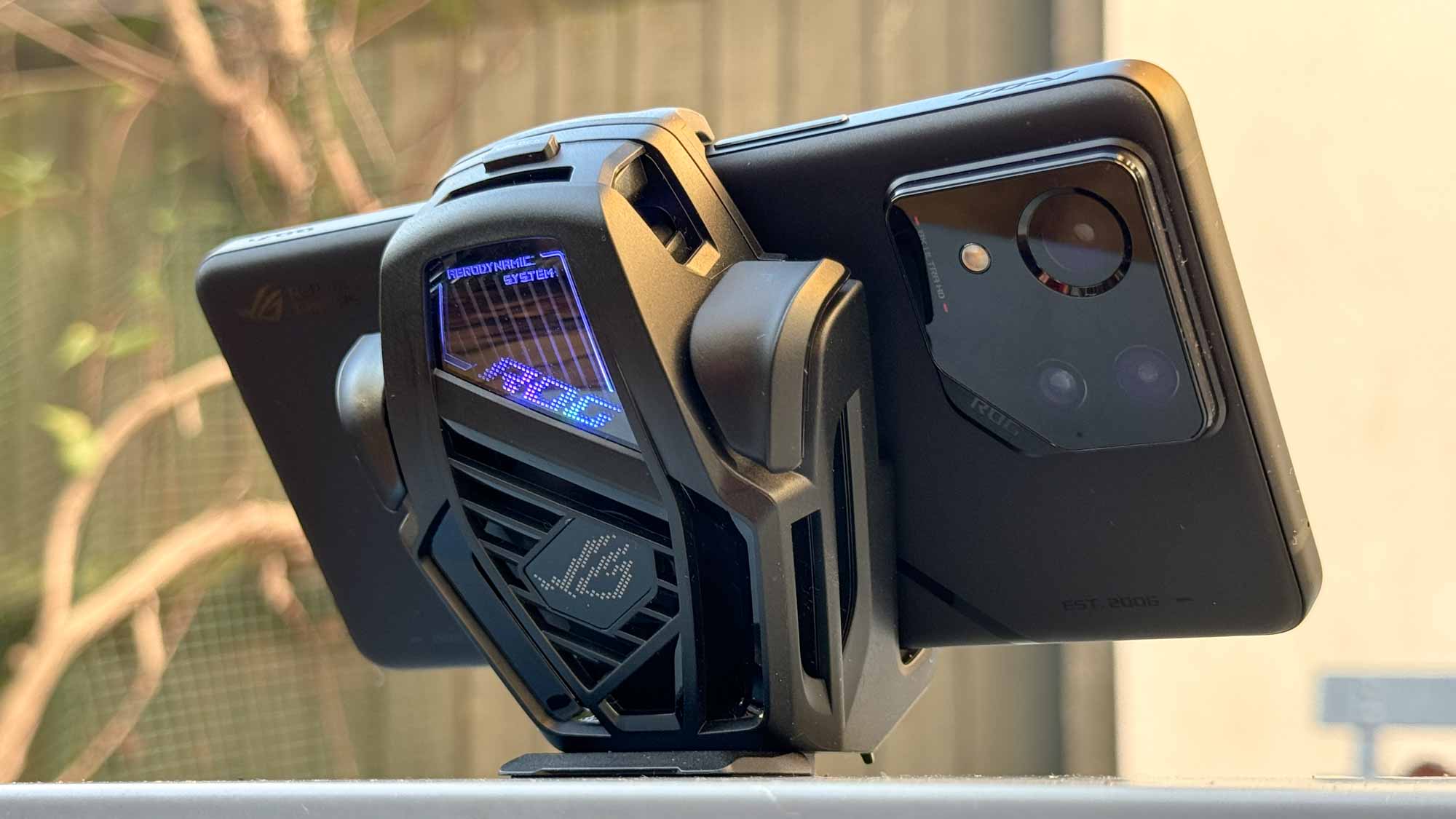Tom's Guide Verdict
Asus is trying to redefine the gaming phone with the ROG Phone 8 Pro, improving some of the rough edges associated with this kind of device. As a result, the ROG Phone 8 Pro offers the same basic abilities as other premium phones, including a telephoto lens. While it still delivers power and a long-lasting battery, the ROG Phone 8 Pro now offers a more complete premium Android experience.
Pros
- +
Blistering performance
- +
Unbeatable battery life
- +
More gaming features than ever
- +
New telephoto camera
- +
More practical, water-resistant design
Cons
- -
Photography remains weak
- -
Expensive compared to other gaming phones
Why you can trust Tom's Guide
The ROG Phone 8 Pro bears the name of Asus' gaming-focused sub-brand, but this phone targets a much wider audience than any of its predecessors. And that move pays off, at least in part.
Asus is bold in wanting the phone to rival flagship staples like the Galaxy S23 Ultra (not to mention the upcoming Galaxy S24 Ultra) or iPhone 15 Pro Max, while still challenging dedicated gaming phones such as the recent RedMagic 9 Pro. Fortunately for the ROG Phone 8 Pro, its upgraded cameras and more user-friendly design revisions join the ROG Phone’s typically great performance, power efficiency and ample selection of game-enhancing features. It's the most balanced ROG Phone yet, and Asus' best effort to sway the average phone buyer to its side.
You may still prefer to make another brand's flagship phone your next purchase if you value good photos or overall value for money. But Asus still makes one of the best gaming phones around, while proving that mobile gaming fans don't have to sacrifice as much as they once did for an excellent gaming device that doubles as a great handset.
Asus ROG Phone 8 Pro: Specs
| Asus ROG Phone 8 Pro | |
| Price | $1,199/£1,099 |
| Display | 6.78-inch FHD OLED |
| Display resolution | 1,080 x 2,400 |
| Refresh rate | 1 - 120Hz (adpative), 165Hz |
| Rear cameras | 50MP gimbal-stabilized main (f/1.9), 13MP ultrawide (f/2.2), 32MP 3x telephoto (f/2.4) |
| Front camera | 32MP selfie |
| Chipset | Snapdragon 8 Gen 3 |
| RAM | 12GB/16GB/24GB |
| Storage | 256GB/512GB/1TB |
| Battery | 5,500 mAh |
| Charging | 65W wired, 15W wireless |
| Colors | Phantom Black |
| Size | 6.45 x 3.02 x 0.35 inches (163.8 x 76.8 x 8.9 mm ) |
| Weight | 7.94 ounces (225g) |
Asus ROG Phone 8 Pro review: Price and availability
Asus is offering the ROG Phone 8 series, including the 8 Pro model, for pre-order until February 4, after which open sales begin.
The standard Pro model costs $1,199/£1,099, and comes with 16GB RAM and 512GB storage, which should be more than enough memory for even the most demanding user. But there's also a $1,499/£1,299 "Pro Edition" bundle, which includes an AeroActive Cooler X accessory in the box as well as an even more generous 24GB RAM/1TB storage memory package.
The standard ROG Phone 8, which differs only in design and available storage, starts at £949/$1,099.
Asus ROG Phone 8 Pro review: Design
The difference between last year's ROG Phone 7 design and that of the new ROG Phone is similar to dragging your favorite gaming fanatic from their lair and frog-marching them down to the mall for a haircut and some office-friendly casualwear. It's quite a transformation, even if it may feel a little uncomfortable.
Get instant access to breaking news, the hottest reviews, great deals and helpful tips.
Available only in a single all-black design with just a few glossy logos and slogans hinting at the device's gaming genes, the ROG Phone 8 feels very restrained. About its most edgy detail is the camera block featuring its asymmetrical shape and ROG branding, but even that's not particularly distracting from a distance. Viewing the ROG Phone 8 from the front, you'd probably not be able to tell it was a gaming phone at all if the display was switched off.

The benefits of this more conventional smartphone design are easy to see. The bezels surrounding the screen have been much reduced compared to the ROG Phone 7. That’s especially true on the top since Asus has given the ROG Phone 8 a modern punch-hole selfie camera instead of retaining the bezel for another year in the name of not covering part of the screen with a cutout while gaming. Don't worry if you think that will pose a problem, though, as you can set the display to shrink a little when playing, preventing the camera from hiding any part of your in-game HUD.
The ROG Phone 8 is shorter and wider than its predecessor, but also a little thinner, making the phone a more convenient size for storage and use. At 7.9 ounces, the ROG Phone 8 is also a little lighter than the 8.4-ounce ROG Phone 7 series.
Once you turn on the ROG Phone 8 Pro, you will see the AniMe Vision lighting system on the back. This network of 341 LEDs is invisible unless in use, at which point it can display specific logos, graphics and animations (including your own custom creations) set according to what you're using the phone for at a given moment. A lot of this is purely for style but you can use AniMe vision for practical purposes like displaying your battery percentage or incoming notifications when the phone is set face down.

This light-up LED matrix somehow isn't the strangest thing about the design of the ROG Phone 8 Pro. Rather, it’s the ROG Phone 8 Pro’s two USB-C ports: one on the bottom edge (but aligned with the left corner rather than the center of the device) and one on the left side. That second port lets you use a charger or the AeroActive Cooler accessory with the phone held horizontally, making it easier to recharge the phone when gaming.
On top of those two charging ports, you still get a headphone jack, making this one of the most expensive phones to still keep this port around rather than forcing users into adopting a USB-C dongle or going fully wireless.

It's a bit of a shame that the Phantom Black colorway you see in these photos is your only color option for the ROG Phone 8 Pro. Perhaps it fits in with the phone's grown-up ambitions that there's no white or gray, but having no choice at all seems a bit mean.
Even with its extra ports, the ROG Phone 8 Pro has managed to achieve an IP68 dust/water resistance rating for the first time. (It’s a first for gaming phones in general too.) There's no longer a cooling vent cut into the phone's body to offer unwanted particles a handy shortcut to the heart of the phone. Combine this IP rating with a Gorilla Glass Victus 2 display, and the ROG Phone 8 Pro should be just as durable as the best Android flagships.
Asus ROG Phone 8 Pro review: Display
Asus downsized the ROG Phone 8 Pro's display a little from last year, but not noticeably. You still get a 6.78-inch FHD OLED display (instead of a 6.8-inch one) on the front of the phone, which we wish had QHD resolution to match up better with other Android flagship phones. But perhaps the lower resolution a fair trade-off for power consumption, considering the ROG Phone’s higher refresh rate.

Like other top Android devices, the ROG Phone 8’s display features an adaptive 1-120Hz refresh rate for normal use. However, it includes a 165Hz fixed refresh rate for playing certain supported games at maximum smoothness. You won't see this come into play quite as often as the standard 120Hz, but it'll be a boon with the right app.
| Asus ROG Phone 8 Pro | Samsung Galaxy S23 Ultra | iPhone 15 Pro Max | |
| Peak brightness (nits) | 1,637 | 1,444 | 1,550 |
| DCI-P3 gamut coverage (%) | 112.4 (default Optimal), 122.5 (Natural) | 136.7 (default Vivid), 78.8 (Natural) | 84.5 |
| Delta-E color accuracy (lower is better) | 0.31 (default Optimal), 0.29 (Natural) | 0.37 (default Vivid), 0.30 (Natural) | 0.14 |
In our display testing, we found that the ROG Phone 8 Pro beats the Samsung Galaxy S23 Ultra in all key metrics. The iPhone 15 Pro Max meanwhile does a better job of challenging the ROG Phone 8's amazing brightness, and offers much more accurate color based on the lower Delta-E score. (The closer to zero, the more accurate the colors.) Although the Galaxy S24 series could change things, the ROG Phone 8's in a great position when it comes to screen quality.

Lots of Android phones offer always-on displays, but Asus has made a different version of it for the ROG Phone 8. Since it no longer has a thick top bezel that can hide an alert LED, you instead get the Screen Light — tiny icons to represent charging status and other important info. It's an interesting idea, although it feels like more could be added to this miniaturized AOD. A scaling feature would make things more readable from a distance as well.
Asus ROG Phone 8 Pro review: Cameras
With the ROG Phone 8, Asus seems to be trying to buck gaming phones’ reputation for having weak photography. For one, Asus swapped out the ROG Phone 7's 5MP macro camera for a 32MP telephoto camera with 3x optical zoom. It's an admission that a phone at this price deserves a full camera loadout, even if photography isn't its primary function. It’s one of the biggest upgrades to a phone that's improved plenty of other specs.

Combined with a gimbal-stabilized 50MP main camera, a 13MP ultrawide camera and 32MP selfie camera, the ROG Phone 8 Pro boasts very similar specs to some of the best camera phones on the market. This is why the following comparisons with the Galaxy S23 Ultra — a similarly-priced phone with a greater focus on photography — are more relevant than ever before. The Galaxy S23 Ultra will soon be replaced by a new Galaxy S24 Ultra, but it’s a phone thats set the standard for mobile photography and a good measuring stick for how far the cameras on the ROG Phone 8 Pro have advanced.
Looking out over the fields at Northumberland's Wallington Hall, there's an obvious difference in the vibrancy and contrast of the images. The richness of the greens and yellow of the grass is more noticeable in the ROG Phone's image, but you can more easily see the different textures in the blades and clover when looking at the Samsung version.
Moving to a night mode shot of a decorated tree at the Alnwick Gardens, we see the ROG Phone's photography at its weakest. The tiny pinpricks of light are not as sharp as the ones on the Galaxy S23 Ultra photo, and its colors are flat and unappealing.
I was able to appreciate the ROG Phone’s gimbal-stabilized camera when aiming still photos, but it proved its most beneficial when recording video as well. Even the ROG Phone 8 Pros regular Adaptive mode creates far steadier footage than the Galaxy S23 Ultra does.
The phones offer similar color and detail characteristics in the ultrawide photos here of Wallington Hall itself to the main camera shots we just looked at. The S23 Ultra's image fits more in with its wider-angle lens, and also produces a brighter and more detailed image, giving us a better idea of the unique shape of each flagstone and emphasizing the reflections in the rain-slick ground.
The ROG Phone's 32MP telephoto camera can only produce 8MP shots due to the way Asus has decided to pixel-bin photos. This is likely why the Samsung take on this signpost not only looks brighter but also sharper, since the Galaxy S23 Ultra uses 10MP sensors for its telephoto cameras.
Asus' 32MP selfie camera on the ROG Phone 8 Pro also produces 8MP shots, although it doesn't seem to be as much of a burden in this comparison. The image from the Galaxy S23 Ultra is softer, with less dramatic shadows across my face, and also a more natural look, with the Asus smoothing out the texture of my skin. The Galaxy phone also gets the portrait effect cut out around my glasses almost right, while the Asus ignores the frame and blurs it right up to my face.
Asus ROG Phone 8 Pro review: Performance
Asus has adopted the Snapdragon 8 Gen 3 as the ROG Phone 8 Pro's chipset, and has put it to good use, as we'll see in the benchmark results below. Joining that chip is 16GB of RAM in the standard Pro, or an impressive 24GB in the Pro Edition we tested.
The thing to bear in mind with gaming phones — or indeed other gaming-focused devices — is that their gaming-ness can come from features rather than raw power. We've seen several times in the past that the ROG Phone doesn't necessarily outperform the competition on benchmarks, although right now, it appears it's certainly capable of doing so.
| Asus ROG Phone 8 Pro | Samsung Galaxy S23 Ultra | iPhone 15 Pro Max | |
| Chipset | Snapdragon 8 Gen 3 | Snapdragon 8 Gen 2 for Galaxy | A17 Pro |
| Geekbench 6 (single-core / multicore score) | 1,339 / 6,543 | 2,091 / 5,081 | 2,783 / 6,945 |
| 3DMark Wild Life Extreme Unlimited (score / fps) | 4, 664 / 27.9 | 3, 788 / 22.7 | 3, 481 / 20.8 |
In the table above, we see that the ROG Phone beats the Galaxy S23 Ultra on CPU and GPU performance except for single-core Geekbench 6 test, perhaps due to the Galaxy S23 Ultra using a tuned-up chip with a higher core speed. It'll be interesting to see if the Galaxy S24 Ultra, which is expected to use the same Snapdragon 8 Gen 3 chip as the ROG Phone 8 series, will be able to close this performance gap.
Although the iPhone 15 Pro Max offers superior CPU performance overall, the ROG Phone isn't that far behind on the multicore score, and it beats the top iPhone handily on the graphics benchmark.

But in true video game boss style, the ROG Phone 8 Pro is holding back its full power with this first phase of results. You can enable what Asus calls X Mode for even higher performance. It's more power-hungry, but it's able to out-muscle even the iPhone 15 Pro Max with it enabled, as this table shows.
| Asus ROG Phone 8 Pro (X Mode enabled) | Samsung Galaxy S23 Ultra | iPhone 15 Pro Max | |
| Geekbench 6 (single-core / multicore score) | 2,249 / 7,079 | 2,091 / 5,081 | 2,783 / 6,945 |
| 3DMark Wild Life Extreme Unlimited (score / fps) | 5,196 / 31.12 | 3, 788 / 22.7 | 3, 481 / 20.8 |
Storage on the ROG Phone 8 Pro is 512GB by default, or 1TB on the Pro Edition. Considering only a few flagship phones offer 256GB storage by default, Asus is being quite generous, which is just as well considering how much space mobile games can take up.
Asus ROG Phone 8 Pro review: Battery and charging
The ROG Phone 8 Pro's 5,500 mAh battery is large compared to the 5,000 mAh cells used in most Android phones. But unfortunately, this power pack is also smaller than the 6,000 mAh cell in the ROG Phone 7 due to the redesigned body. Asus has promised that this shouldn’t impact battery life too much, and in our testing, we found the new ROG Phone performs even better than ever.
We recorded the ROG Phone 8 Pro lasting 18 hours and 48 minutes on our custom battery test while in automatic refresh rate mode, reaching 18 hours and 56 minutes when we locked the refresh rate at 60Hz. Both of these times are better than what the Asus ROG Phone 7 Ultimate was able to achieve with its larger battery. They also crush the 12 hours and 22 minutes and 14 hours and 2 minutes results of the Galaxy S23 Ultra and iPhone 15 Pro Max, respectively. The ROG Phone 8 Pro is our new best phone battery life champion.
Asus includes a 65W wired charger in the ROG Phone's box. In my own testing (conducted outside of the TG labs), the phone charged to 36% from empty in 15 minutes and 71% in 30 minutes. It became fully charged after 50 minutes. That’s quick, certainly compared to many other premium phones, but not one of the fastest charging phones we've seen.
There's also 15W Qi wireless charging for the first time too. While it won't power your phone up nearly as quickly as the wired charger, it is a convenience previously missing from past ROG Phones that we're happy to see here.
Asus ROG Phone 8 Pro review: Software and special features
Android 14 comes pre-installed on the Asus ROG Phone 8 Pro, but the update schedule for future updates is disappointing. You only get two full Android updates, and four years of security updates with this device. While consistent with Asus' Zenfone 10 update policy, it’s way behind the four or more years that Samsung offers with the Galaxy S23
What perhaps matters more to the gaming-focused user is all the features Asus will give you in the meantime. And the good news there is there are plenty of them.
First off there's the Armory Crate app, which houses shortcuts to all of your installed games and the ROG-specific gaming-centric options, such as performance profiles and the AniMe Vision lights we mentioned above. It makes for a handy hub for gaming, and stops you from having to clog up your home screens with game icons.

It's through the Armory Crate that you can enable the capacitive AirTriggers for your games. They don't give a huge amount of feedback but between the haptic buzz you get as you tap them, and the tactile of the engraved ROG logo that marks each button, they feel alright to use. They're certainly very useful in certain games, particularly shooters, although you do have to set them up and select which part of the display they tap for each one. You can even split each trigger into two zones for four total virtual buttons, although I found this too fiddly to be practical myself.
When you're playing, you can make use of the ROG Phone’s new "AI Grabber" feature, which will detect on-screen text and then let you make a Google search with the detected words you select in a pop-up window. It proves a nice shortcut when you need help with something but don't want to exit the game and don't have a second device on hand.

AI also features on the ROG Phone 8 Pro in the form of machine learning-powered noise cancellation for voice calls, and some AI features for specific games like Genshin Impact or Honkai Star Rail that help streamline the looting system or skip through dialog. There's Dirac Virtuo spatial audio for immersive listening, too.
All of these features mean the ROG Phone 8 Pro will generate some heat, but luckily there's a reworked cooling system to pass heat from the silicon to the phone's casing. That likely means you'll feel the heat more than on older ROG Phones, but if you can feel the phone's body getting warm, that means the heat's not impacting the internals, hopefully meaning they're working at optimum performance levels for longer.
And if that's not enough extras, there's Asus' $99 AeroActive Cooler accessory, which comes included with the Pro Edition version of the phone as well as with some pre-order bundles for the other models. This is primarily a pocketable cooling fan that slots into the ROG Phone 8's side USB-C port, but it's got more to it than that.

The cooler adds two physical trigger buttons that can be used in conjunction with the capacitive AirTriggers for a maximum of six trigger buttons. There's also customizable RGB lighting, USB-C passthrough to charge the phone and another headphone jack to stop the phone's built-in one from getting in the way of your horizontal grip.
All of this normally runs from your phone's battery, but using the highest-performance Frozen mode requires your device to be plugged in. That enables the phone's maximum power output, known as X Mode Plus.
In other words, the AeroActive Cooler X adds a lot to the ROG experience. But other than professional gamers, I am not sure who's going to carry around the cooler regularly, especially when you already have enough power and customizability with the features present on the ROG Phone by itself.
Asus ROG Phone 8 Pro review: Verdict
Perhaps gamers who can't get enough of RGB lighting and aggressive product designs will find the Asus ROG Phone 8 Pro underwhelming. But the new ROG Phone's move toward regular premium smartphone features is a smart one now that mobile gaming's rivals no longer include just the Nintendo Switch but also the Backbone One, PlayStation Portal, Steam Deck and even Asus' own ROG Ally.

The ROG Phone 8 Pro has to make more of a case for itself as a phone than ever before, and fortunately, it does a decent job of that. I'd feel happy recommending this to less gaming-focused phone buyers in a way I wouldn't with older ROG Phones, even if this phone’s strengths remain focused on performance.
I'd caution anyone wanting to buy now to wait and see what the Samsung Galaxy S24 series can do with similar tech and a likely superior camera system, given Samsung’s track record with camera phones. Plus the RedMagic 9 Pro is a far more cost-efficient gaming phone, sharing many of the same features with the ROG Phone.
But people who want an Android phone with exceptional battery life and will make use of the Armory Crate's bountiful contents as much as or more than their phone's cameras could find the ROG Phone 8 Pro bridges the gap between gaming and premium phone experiences in a way that no other handset can.

Richard is based in London, covering news, reviews and how-tos for phones, tablets, gaming, and whatever else people need advice on. Following on from his MA in Magazine Journalism at the University of Sheffield, he's also written for WIRED U.K., The Register and Creative Bloq. When not at work, he's likely thinking about how to brew the perfect cup of specialty coffee.

